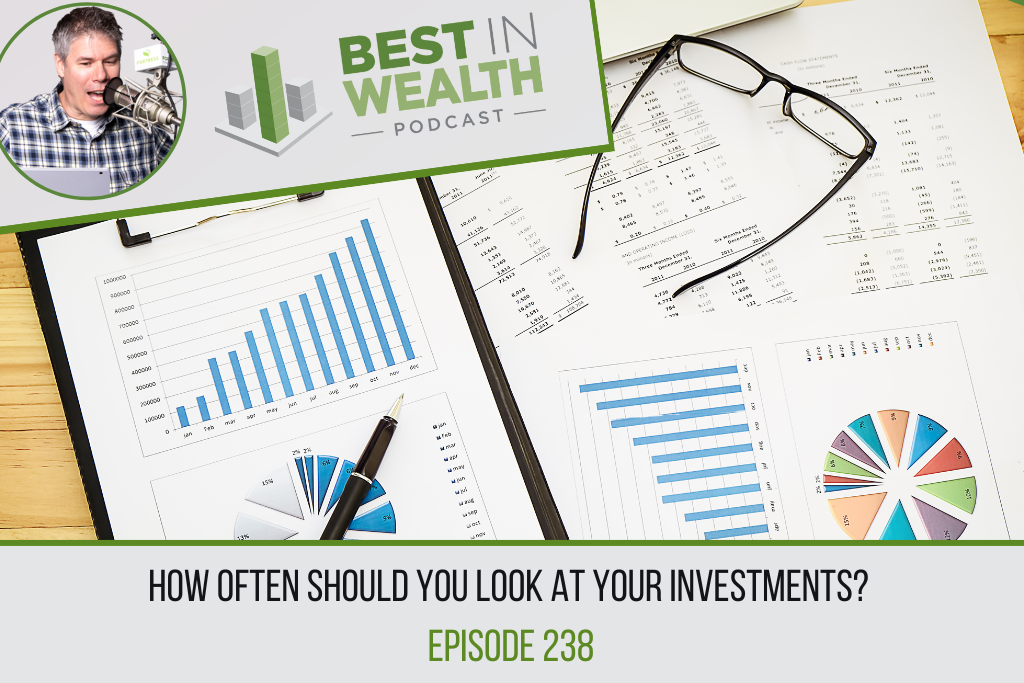How Often Should You Look at Your Investments? Ep #238

How often should you look at your investments? Some of my clients look at their investments every day. Some look weekly, monthly, quarterly, annually—and some never look at them. So what is my answer? It depends. After listening to this episode of Best in Wealth, you will know how often you should check on your investments (based on you).
How often should you look at your investments? Some of my clients look at their investments every day. Daily, monthly, weekly, quarterly, or annually? I share my surprising answer in this episode of Best in Wealth! #Investing #Invest… Click To TweetOutline of This Episode
- [2:18] Whole30: The importance of consistency and discipline
- [6:51] The third-best tennis player in the world
- [9:52] The track record of the S&P 500
- [17:51] What looking at the S&P 500 tells us
- [20:55] How many times should you look at your portfolio?
The third-best tennis player in the world
Let’s talk about tennis for a minute. Roger Federer was one of the top three tennis players of all time. He is elite. Of the millions of tennis players who grew up playing, got scholarships, and played the best they possibly could at the pro level, Roger was one of the best.
- Roger won 20 Grand Slam Men’s Single titles, the 3rd most of all time.
- He is the only player to win five consecutive US Open titles.
- He won 40 consecutive matches at the US Open.
- He is the second male player to reach the French Open and Wimbledon finals in the same year for four consecutive years.
- He is the only male player to appear in at least one Grand Slam Semi-Final for 18 consecutive years.
- He won eight Wimbledon titles.
He is one of the best to ever play the game. But what does any of this have to do with investing?
What does the third-best tennis player in the world have to do with #investing? Find out in this episode of Best in Wealth! #Investing #Invest #RetirementPlanning Click To TweetThe track record of the S&P 500
Let’s switch gears and talk about the S&P 500 (which you can not invest in but it is a benchmark). The S&P 500 has had an amazing track record. The average return is a little over 10% per year. But what does that mean? What does a 10% return look like?
Let’s compare the S&P 500 to a high-yield savings account. A 10% return means that every seven years, your money will double. If you have $1 million in investments—and actually earn 10%—it will be $2 million in seven years.
The rule of 72 says that if you divide 72 by your interest rate, that is the number of years it will take to double. So if you put your money in a high-yield savings account—likely earning around 4.5% right now—it will take 16 years to double. That is why we need to invest in some things that will grow faster—even faster than a high-yield savings account.
What does any of this have to do with Roger? In tennis, each time someone serves the ball, you are playing for a point. When you get enough points, you win the set. When you win enough sets, you win the match.
He is one of the best players ever—but he only won a point 54% of the time. Roger won 75% of his sets. And Roger won 81% of his matches. You are probably thinking, “Scott—how does this have anything to do with how often you should look at your investments?” Stick with me.
What does the S&P 500 and Roger Federer have in common? I share some surprising facts in this episode of Best in Wealth! #Investing #Invest #RetirementPlanning Click To TweetWhat looking at the S&P 500 tells us
The S&P 500 plays a game every time the stock market is open. How often is the S&P 500 positive or negative? Let’s call a positive result a “win” and a negative return a “loss.” The S&P 500 is positive 53% of the time and negative 47% of the time.
If you look at your statements quarterly—like Roger playing a set—the S&P 500 is positive 71% of the time (going back to the 1930s). What about annually? If you look at your statements annually, the S&P 500 is up 78% of the time annually. 8 out of 10 times, you are positive. That is why you typically see a 10% return on the S&P 500.
When you look at your statement every day, you will be disappointed half the time. If you look at your statement quarterly, you are only disappointed 29% of the time. If you look at your statement every year, you will only be disappointed 22% of the time. Which sounds better to you?
When your portfolio is not doing well, it feels twice as bad as when it is doing well. Too much anxiety leads to a desire for change. When you make too many changes, you disrupt everything.
What’s the best choice for you? Listen to the whole episode so I can help you make the most informed decision for you.
Looking at the S&P 500 tells us how often we should look at our investments. How? I share my thoughts in this episode of Best in Wealth! #Investing #Invest #RetirementPlanning Click To TweetResources Mentioned
Connect With Scott Wellens
- Schedule a discovery call with Scott
- Send a message to Scott
- Visit Fortress Planning Group
- Connect with Scott on LinkedIn
- Follow Scott on Twitter
- Fortress Planning Group on Facebook
Audio Production and Show notes by
PODCAST FAST TRACK
https://www.podcastfasttrack.com
Podcast Disclaimer:
The Best In Wealth Podcast is hosted by Scott Wellens. Scott Wellens is the principal at Fortress Planning Group. Fortress Planning Group is a registered investment advisory firm regulated by the US Securities and Exchange Commission in accordance and compliance with securities laws and regulations. Fortress Planning Group does not render or offer to render personalized investment or tax advice through the Best In Wealth Podcast. The information provided is for informational purposes only and does not constitute financial, tax, investment or legal advice.



